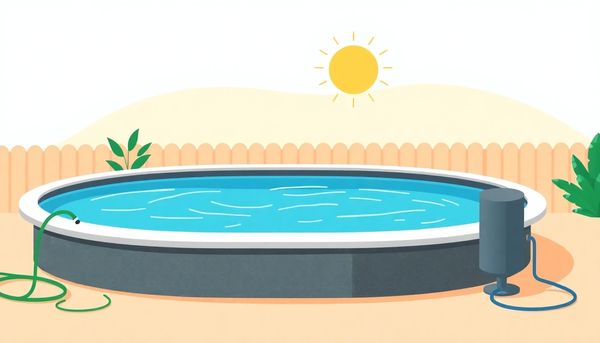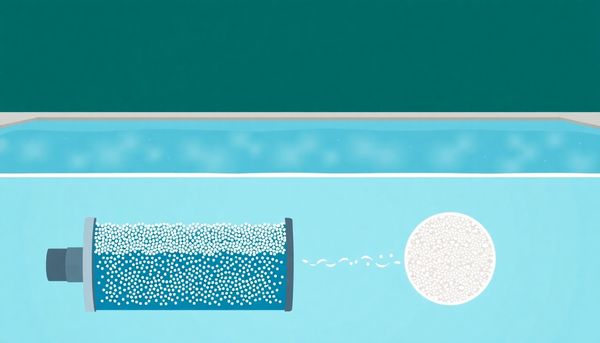Is a DE Filter Better Than a Sand Filter for Your Pool?
September 17th, 2024
September 17th, 2024
A backyard pool can be the heart of summer fun, offering a cool reprieve from the heat. But keeping that oasis crystal clear isn't always as simple as a dip in the water. The battle against cloudy water and stubborn debris often leads pool owners to explore various filtration systems. Among the contenders, Diatomaceous Earth (D.E.) filters stand out due to their reputation for superior water clarity. Yet, the question lingers: is a D.E. filter truly an upgrade over the traditional sand filter?
At the core of a D.E. filter's effectiveness is a natural material—a soft, crumbly rock comprised mainly of fossilized remains of tiny aquatic organisms. This unique component is renowned for its ability to filter out particles as small as two to five microns. In practical terms, it means even the tiniest impurities are captured, leaving the water remarkably clear. I remember visiting a friend's pool after they switched to a D.E. filter; the water almost sparkled, and the frequent bouts of murky water were a thing of the past.
Moving beyond surface appearances, it's also essential to consider maintenance and longevity. While sand filters are generally easier to maintain, requiring less frequent cleaning, they don’t quite match the precision of D.E. filters. For pool owners seeking pristine water and willing to handle more detailed care, understanding the mechanics and benefits of D.E. filters becomes imperative. As we delve further, the comparison between these two popular systems will reveal which might best suit your backyard bliss.

Diving into the world of pool filters reveals a gem known as the D.E. filter, short for diatomaceous earth filter. This type of filter stands out for its exceptional ability to capture the tiniest impurities in your pool water. Unlike its sand filter cousin, which traps particles sized 20 to 40 microns, the D.E. filter can seize particles as minute as 1 to 6 microns. This means that it efficiently captures debris like skin flakes or microscopic pollutants that often escape sand filters.
Reflecting on my own experience, I recall a summer pool party when the clarity of my water became a topic of admiration. Guests were amazed at how pristine my pool appeared, thanks to the D.E. filter. This sparkling clarity wasn’t just about aesthetics; it also contributed to a healthier swimming environment by reducing the presence of unseen contaminants.
Yet, while the D.E. filter provides unparalleled cleanliness, it does come with its demands. Regular maintenance, including backwashing and replenishing the D.E. powder, is necessary to keep it functioning optimally. Despite these tasks, many pool owners, myself included, find the trade-off between maintenance and water quality well worth it. For those seeking crystal-clear pool water, investing in a D.E. filter offers significant benefits that are hard to match by other filtration systems.
In the world of pool maintenance, selecting the right filter type can feel like navigating a vast ocean of choices. Each filter type—be it diatomaceous earth (D.E.), sand, or cartridge—brings its own set of advantages and challenges. Let's uncover what makes a D.E. filter a gem for some and a puzzle for others.
First off, if you're the kind of person who admires crystal-clear pool water, the D.E. filter might speak to your heart. Its ability to trap particles as minuscule as one micron is unmatched, offering water clarity that turns an ordinary swim into a luxurious dip. However, this comes with a trade-off: maintenance. A story from my friend, Lisa, comes to mind—her sparkling pool was a neighborhood envy, but she spent considerable weekends cleaning the D.E. grids and ensuring the powder was just right.
Assessing your pool's needs becomes crucial. For those with larger, more frequently used pools, the superior filtration of a D.E. system can be worth the effort. However, if convenience and lower upfront costs are your priority, sand or cartridge filters may serve you better. Consider your energy levels for upkeep and your budget constraints. A pool, after all, is not just a backyard feature but a lifestyle choice—one that should harmonize with your daily rhythm. Whether you prioritize impeccable water quality or hassle-free operation, choosing the right filter is about aligning with what suits your pool's personality and your own.
Choosing a pool filter can feel like navigating a maze, but understanding how to maximize the filtration efficiency of a D.E. filter might just make it the clear winner. These filters operate with a unique level of precision, using the microscopic power of diatomaceous earth to trap particles as tiny as one micron. It's this capability that sets them apart from sand filters, which handle larger particles. To get the most out of a D.E. filter, it's essential to grasp a few key practices.
Start by ensuring the filter is correctly sized for your pool—this means accounting for the pool’s surface area and the turnover rate required to keep your water sparkling. An adequately sized D.E. filter will circulate all the pool water through the system at least once a day, ideally three times for optimal cleanliness.
Regular maintenance is crucial. Although it requires more effort than its sand counterpart, a clean D.E. filter operates at peak performance. Backwashing, followed by a fresh application of D.E. powder, ensures that the filter cake remains effective in trapping fine debris.
Pay attention to water chemistry, too. Balanced water prevents scale and mineral deposits from clogging the filter, which could diminish its efficiency. Think of it like maintaining a bike: a little grease and regular check-ups keep it running smoothly for longer rides. In a similar fashion, a D.E. filter, when meticulously cared for, offers an unrivaled swimming experience with crystal-clear water.
Maintaining a D.E. filter might seem daunting at first, but simplifying the process is all about establishing a routine and understanding the steps involved. Think of it like tending to a small garden; once you get the hang of it, the process becomes second nature. I remember when I first dealt with a D.E. filter—its intricate parts seemed intimidating. However, by breaking down the cleaning into manageable tasks, it became a straightforward part of my pool upkeep.
Firstly, backwashing the filter to remove the build-up is essential. This involves reversing the water flow to flush out debris. Picture it as giving your filter a fresh start. Following backwashing, a fresh layer of D.E. powder is added through the skimmer line. This step is crucial, as the powder forms the filter cake that captures fine particles. It's akin to changing the oil in your car to ensure it runs smoothly.
In addition to regular backwashing, periodically dismantle the filter for a thorough cleaning. This involves rinsing the grids or soaking them in a cleaning solution, such as muriatic acid, to break down stubborn residues. Scheduling this deep clean can prevent issues and extend the life of your filter. Over time, these steps become a rhythm, ensuring your pool stays sparkling with minimal fuss. With consistent care, a D.E. filter operates efficiently, offering superior filtration without the hassle.

Maintaining a D.E. filter is not merely a task; it's a ritual that ensures your pool remains a sparkling oasis. This type of filter requires special attention, akin to nurturing a prized garden. When I first became a pool owner, the intricacies of D.E. filter maintenance felt daunting. However, understanding the process turned it into a rewarding routine.
Start by backwashing the system, a necessary step to clear out debris. Unlike sand filters, which simply need a flip of a valve, D.E. filters demand a more hands-on approach. After shutting off the pump, switch the multiport valve to the backwash setting, and let the water run clear. This reversal in flow shakes loose the dirt clinging to the filter grids. Consider it a deep breath for your filtration system.
Next, comes the dismantling. Remove the grids carefully, placing them on a flat surface, ready for a good hose-down. If stubborn grime persists, a soak in a diluted muriatic acid solution might be in order. It's like giving your filter a spa day, rejuvenating its ability to trap even the tiniest particles.
Reassembly follows, where precision is key. Ensure everything is snug and secure before adding fresh D.E. powder through the skimmer. Like a chef adding the final seasoning, this step completes the process, returning your pool to its pristine glory.
Frequent maintenance not only preserves the life of your D.E. filter but also enhances the pleasure of owning a pool. With each cycle of care, your pool's clarity and cleanliness become a testament to your dedication.
Understanding the nuances of pool filtration can feel like navigating a labyrinth, but choosing the right filter is the key to maintaining pristine waters. D.E. filters, known for their superior ability to capture microscopic particles, stand as a favorite among pool enthusiasts who prioritize crystal-clear water. However, this efficiency comes at a cost—both financial and in terms of maintenance effort.
Consider your pool's unique needs. An inground pool with a high bather load and frequent exposure to debris may benefit greatly from a D.E. filter. These filters, capable of trapping particles as small as one micron, ensure that even the tiniest contaminants are removed from your pool. On the flip side, for smaller above-ground pools or those on a tighter budget, sand filters may suffice, providing adequate filtration with less upkeep.
Maintenance is another crucial factor. D.E. filters require regular backwashing and the recurring task of adding diatomaceous earth powder. While this process can be labor-intensive, it rewards you with the clearest water. If you’re the kind of pool owner who doesn’t shy away from a little elbow grease, a D.E. filter could be your ideal partner.
Ultimately, the decision hinges on balancing your desire for top-notch water clarity with the realities of maintenance and cost. By understanding each filter's strengths and limitations, you can make an informed choice that aligns with both your lifestyle and your pool's demands.
Maintaining a D.E. filter requires a bit of dedication, but it's a rewarding task for those seeking pristine pool water. My neighbor once boasted about the clarity of his pool, crediting his diligent care of the D.E. filter. The secret? Regular cleaning and mindful maintenance.
Start by understanding the anatomy of your D.E. filter. It comprises grids or fingers coated with diatomaceous earth, a powdery substance that traps debris. Over time, this filter cake accumulates particles, reducing efficiency. To revitalize it, remove the grids and gently hose them down. If stubborn grime persists, a soak in a diluted muriatic acid solution does wonders, breaking down oils and minerals that cling stubbornly.
Backwashing is another essential step. This process reverses water flow, flushing out trapped debris. It's like giving your filter a breath of fresh air. However, remember to add fresh D.E. powder afterward. Without replenishing this crucial component, your filter can’t function optimally. My first attempt at this was a messy affair, but practice makes perfect.
Keep an eye on pressure levels, too. High pressure indicates it’s time for a cleaning. A little vigilance goes a long way in preventing wear and tear. With regular attention, your D.E. filter not only ensures sparkling water but also extends its own lifespan, making each sunny pool day a clear success.
Navigating the world of pool filters can feel like choosing between adventure novels—each offers its own unique journey toward a common goal. Among the protagonists are D.E. filters and sand filters, both trying to keep your pool as clear as a mountain spring. The D.E. filter stands out for its ability to trap particles as minuscule as 1 to 6 microns, a feature unmatched by sand filters that only catch particles down to 20 microns. Consider them elite detectives of the pool world, leaving no tiny clue behind.
However, such precision comes at a cost. D.E. filters, resembling high-maintenance thoroughbreds, demand a more involved care routine. Regular dismantling for cleaning and replenishing the D.E. powder post-backwash is necessary. And while they promise crystal-clear water, their initial price tag ranges from $500 to $2,000, depending on the model's complexity and size. In contrast, sand filters, the workhorses of the pool world, require less pampering and bear a softer financial impact upfront. They cost significantly less and involve simpler maintenance routines, mostly just a regular backwash.
My own pool-owning cousin swears by her D.E. filter for its superior cleaning capability despite the extra elbow grease. It’s a choice between convenience and clarity, budget and brilliance. Your ideal filter might just depend on how much you value that sparkle in your pool—an ultimate reflection of how much you wish to indulge in the art of pool care.
Choosing the ideal filter type for your pool can feel like an overwhelming decision, especially when faced with options like D.E. filters and sand filters. Each filter has its unique strengths, and your choice should reflect both your pool's needs and your willingness to commit to maintenance routines.
A D.E. (diatomaceous earth) filter stands out with its ability to trap particles as small as 1 to 6 microns, offering crystal-clear water unparalleled by sand filters, which typically filter down to 20 to 40 microns. This makes D.E. filters a prime choice if you’re particular about water clarity, perhaps for a pool that frequently hosts gatherings or has high visibility. However, this superior filtration comes with its demands. D.E. filters require regular maintenance, including backwashing and recharging with D.E. powder — tasks that some pool owners might find cumbersome.
On the other hand, sand filters are simpler to operate and maintain, making them a popular choice for those who prioritize ease over precision. They are also more budget-friendly initially, though they may not capture ultra-fine particles effectively, which could be a concern if your pool sees a lot of debris or cosmetic products.
Reflecting on your lifestyle and pool use can guide this decision. If you're willing to invest time in maintenance for unmatched water clarity, a D.E. filter might be worth the extra effort. Conversely, if you prefer a straightforward and cost-effective solution with moderate cleaning efficiency, a sand filter could be your best bet.
When choosing the right pool filter,
Maintaining a D.E. filter is akin to caring for a prized vintage car—it requires attention, patience, and a bit of elbow grease. Each season, as leaves start to drift into your pool, they also hint at the increased care your D.E. filter will need to keep your water pristine. Unlike sand filters, which demand less frequent intervention, D.E. filters excel at capturing the tiniest particles—you know, those stubborn bits of pollen that seem to evade every other cleaning method.
First, routine backwashing is essential. This involves reversing the water flow to purge accumulated dirt from the filter, a step you might find cathartic on a quiet morning. Once backwashing is complete, fresh D.E. powder must be added via the skimmer to reestablish that all-important D.E. cake. Think of it as replenishing the oil in your engine—a necessary ritual to ensure peak performance.
Occasionally, more intensive care is required. This means dismantling the filter to clean the grids, either by spraying them with a garden hose or soaking them in a muriatic acid solution to dissolve stubborn mineral build-ups. This task, though initially daunting, becomes a familiar routine—like changing the oil in that beloved car. Through consistent care, your D.E. filter not only rewards you with crystal-clear water but also extends its lifespan, making each maintenance effort worthwhile.
When it comes to filtration efficiency, the D.E. filter stands in a league of its own. My friend Tom, a self-proclaimed pool enthusiast, once said his D.E. filter was like the high-definition TV of pool filters—capturing every tiny detail in the water. While that might sound exaggerated, it's not too far from the truth. D.E. filters excel at trapping particles as minuscule as 1 to 6 microns. To put that into perspective, human hair is about 70 microns in diameter. So, a D.E. filter doesn’t just skim the surface; it dives deep, capturing everything from minuscule dirt particles to cosmetic residues and even skin flakes.
Many pool owners, including myself, have experienced the frustration of finding cloudy water even after using other types of filters. With a D.E. filter, that scenario becomes rare. Its secret lies in the diatomaceous earth 'cake' that forms on the grids, acting as a fine sieve that lets nothing but clarity through. However, this impressive filtration comes at a price—both literally and in terms of upkeep. The meticulous maintenance required to keep these filters performing optimally can be daunting. Yet, for those dedicated to achieving crystal-clear water, the extra effort is a small price to pay for the peace of mind and the pristine quality of water they provide.

Choosing between D.E. and sand filters is akin to selecting the right tool for your garden: both are effective, but each serves a distinct purpose. My friend Sarah recently faced this dilemma when setting up her first pool. She loved the idea of pristine water clarity and went for a D.E. filter, drawn by its ability to capture particles as minute as 1 micron. This level of filtration means even the tiniest impurities—like cosmetic residues—get trapped, ensuring crystal-clear water.
However, Sarah quickly learned that the superior filtration came with a trade-off. Maintaining a D.E. filter isn't for the faint-hearted. It involves regular backwashing, disassembling grids, and replenishing D.E. powder—a routine that requires dedication. Sand filters, conversely, offer ease and affordability. They tackle particles down to 20-40 microns, which suffices for many households, especially those seeking straightforward upkeep.
While D.E. filters boast unparalleled filtration, they demand a commitment akin to caring for a high-maintenance garden. Sand filters, on the other hand, are like a trusty rake: less precise but easy to handle. Ultimately, Sarah realized her choice hinged on her priorities—pristine water clarity or practical simplicity. For those balancing cost, effort, and the desire for sparkling clean pool water, understanding these nuances is crucial in making an informed decision.
When assessing the filtration efficiency of pool filters, the D.E. filter stands out due to its remarkable ability to trap even the tiniest particles. Unlike its sand filter counterpart, which typically filters particles between 20 to 40 microns, a D.E. filter boasts the capability to capture contaminants as small as 1 to 6 microns. This difference is significant, especially if you've ever worried about microscopic debris like skin flakes or cosmetic residues sneaking back into your pool. It's akin to comparing a magnifying glass to a microscope—both serve their purpose, yet one offers a level of detail the other simply cannot.
Consider a summer barbecue where guests frequently dive into the pool, wearing sunscreen and hair products. A D.E. filter would efficiently clear these remnants from the water, ensuring it remains pristine. While this advanced filtration performance is undoubtedly a perk, it does come with trade-offs. The maintenance involved in keeping a D.E. filter at peak efficiency requires commitment, as it involves regular backwashing and D.E. powder replacement.
However, for those who prioritize crystal-clear water and are willing to invest the effort, the D.E. filter delivers unparalleled results. Its meticulous attention to the smallest of details ensures that every swim feels refreshing, free from the unsightly particles that sometimes evade less efficient systems. If pool clarity is your ultimate goal, the D.E. filter’s superior filtration efficiency might just be worth the extra maintenance.
Understanding the maintenance requirements for a D.E. filter can feel like preparing a gourmet meal—slightly intimidating at first, yet ultimately rewarding. Unlike other filters, the D.E. filter demands a bit more attention, but for those in pursuit of pristine pool water, it’s a worthwhile commitment. Begin by setting aside time on a regular basis to clean and backwash the filter. The process starts with removing the D.E. grid, giving it a thorough rinse, and occasionally soaking it in a muriatic acid solution. This helps strip away persistent oils and mineral deposits that cling to the filter grids, much like stubborn grease on a frying pan.
Regular backwashing is another crucial step. This involves reversing the water flow through the filter to dislodge accumulated debris and contaminants. Think of it as turning your pool filter inside out for a deep clean. Following each backwash, you'll need to replenish the D.E. powder, adding it through the skimmer to form a fresh filter "cake" inside the unit. This ensures continuous and efficient filtration.
Committing to these maintenance tasks not only extends the life of your D.E. filter but also keeps your pool water as clear as a mountain spring. While it may require more effort than a sand filter, the resulting sparkle in your pool water makes the extra work feel like a minor trade-off.
Embarking on a journey to find the perfect pool filter often leads to the pivotal question: how do cost and installation differ between D.E. filters and sand filters? Diving into this realm, you’d notice the initial investment for a D.E. filter might cause a momentary pause. Ranging from $500 to $2,000, the sticker shock is palpable. In contrast, sand filters present a more wallet-friendly option, with prices typically starting much lower.
Reflecting on installation, D.E. filters demand a bit more finesse. Having helped a neighbor with their setup last summer, I can attest that aligning the grids, connecting the plumbing, and accurately mixing the D.E. powder for optimal filtration are crucial steps. Meanwhile, sand filters are the plug-and-play champions of pool maintenance, with installation often involving just a simple connection to the pool system.
However, the allure of D.E. filters lies in their unparalleled ability to cleanse the pool of microscopic particles. Their efficiency might justify the higher cost for those prioritizing pristine water quality. On the other hand, the straightforward maintenance of sand filters—primarily limited to backwashing—saves time and effort, which is a significant advantage for busy pool owners. Thus, whether you choose to invest more upfront for superior filtration or opt for the simplicity and economy of sand filters, understanding these nuances ensures your selection aligns with both budget and maintenance preferences.

Understanding how a D.E. filter operates might feel like unraveling the mystery of clean water. These filters harness the power of diatomaceous earth—tiny fossilized remains of aquatic organisms—to provide superior pool filtration. Imagine each grain of this powder acting as a miniature net, capturing particles as small as 1 micron. This means that impurities invisible to the naked eye, like sunscreen residues or microscopic skin flakes, are trapped, leaving your pool water crystal clear.
The process begins when D.E. powder is added to the filter, where it adheres to the internal grid or "fingers," forming what is known as a D.E. cake. This layer enhances the filter's ability to capture fine particles. While this offers unmatched filtration, it also signals the need for meticulous maintenance. Unlike sand filters, D.E. filters require regular cleaning not only to remove the accumulated dirt but also to maintain efficiency.
Cleaning involves backwashing to flush out trapped debris. Think of backwashing as the filter’s way of taking a deep breath. After backwashing, the grid must be cleaned, often needing a thorough rinse or even an acid bath to remove stubborn oils and minerals. Don’t forget to replenish the D.E. powder to keep the system running effectively. Though maintenance can seem demanding, the reward is sparkling, clean pool water that’s worth the extra effort.
Choosing the perfect DE filter can feel like picking the right coffee blend—it's all about personal preference and specific needs. First, consider the size of your pool—this determines the capacity your filter needs to handle. For sprawling inground pools, a high-capacity model like the Hayward ProGrid might be ideal, thanks to its robust construction and efficient flow. If your pool resembles more of a backyard oasis, the Hayward Perflex could provide adequate filtration without overwhelming your setup.
Next, think about your maintenance comfort level. If you're not one to shy away from a bit of poolside labor, a DE filter's thorough cleaning routine—despite its challenges—might not deter you. However, if the thought of disassembling grids and handling DE powder gives you pause, ensure you're ready for this commitment before diving in.
Consider also the longevity and durability of the materials used in the filter. A model with a corrosion-resistant tank, like those made from fiberglass-reinforced polypropylene, can withstand the test of time and chlorinated water. Finally, ponder your budget. While DE filters offer superior filtration, they come with a heftier price tag and ongoing maintenance costs. Balancing initial investment with long-term benefits will help you determine if a DE filter aligns with your pool care priorities.
When it comes to choosing between a D.E. filter and a sand filter, the decision often boils down to priorities: precision versus ease. Each has its strengths, and understanding these can guide a pool owner toward the right choice for their needs.
D.E. filters are the maestros of fine filtration, capturing particles as small as 1 micron. Imagine the clarity of your water, free from potential intrusions like deodorant particles or tiny skin flakes that escape sand filters' grasp. This meticulous level of cleaning keeps your pool water sparkling and pristine. However, this precision comes with a demand for diligence. D.E. filters require regular maintenance, including backwashing and the addition of D.E. powder, which can be a bit of a chore for the uninitiated.
In contrast, sand filters offer a more straightforward, hands-off approach. They require less frequent cleaning and simpler upkeep, making them a favorite among those who prefer minimal fuss. While they may not match the D.E. filter's capability in removing the finest particles, sand filters effectively handle larger debris, which suffices for many residential pools. Moreover, their initial cost is generally friendlier on the pocketbook, appealing to those mindful of their budget.
Ultimately, choosing between these two involves weighing the desire for ultimate water clarity against the allure of effortless maintenance. Whether you prioritize immaculate water or a hassle-free routine, both filters serve their roles well, each suited to different pool care philosophies.
Maintaining a D.E. filter can be likened to caring for a vintage car—it requires a bit more attention, but the performance makes it worth the effort. The first step in upkeep involves routine backwashing. This process expels built-up debris from the system, enhancing its efficiency. Unlike simpler sand filters, D.E. filters demand careful handling, but this results in significantly cleaner water.
Occasionally, a deeper clean is necessary. Think of it as a spa day for your filter elements. The grids must be removed and rinsed with a garden hose. For those stubborn deposits, a soak in a muriatic acid solution can work wonders, breaking down oils and minerals clinging to the grids. This step not only extends the lifespan of your filter but also maintains the clarity of your pool water.
After backwashing or cleaning, replenishing the D.E. powder is crucial. This powder, essentially fossilized diatom remains, is what gives the filter its superior cleaning capabilities. Pour the recommended amount into the skimmer while the pump runs, allowing it to coat the grids and form a new filtration layer.
Incorporating these maintenance practices into your regular pool care routine ensures your D.E. filter operates at peak performance. Sure, it might ask for more elbow grease than a sand filter, but the reward is sparkling, debris-free water that elevates the swimming experience.

This article provided insights into maintaining your pool. Start your pool care journey today!
Want to become a pool maintenance expert? Our free Pool School course covers everything you need to know about pool care. From basic maintenance to advanced troubleshooting, you'll learn how to:
Join over 10,000 pool owners who have already transformed their pool care routine. Get started with our free Pool School course today!